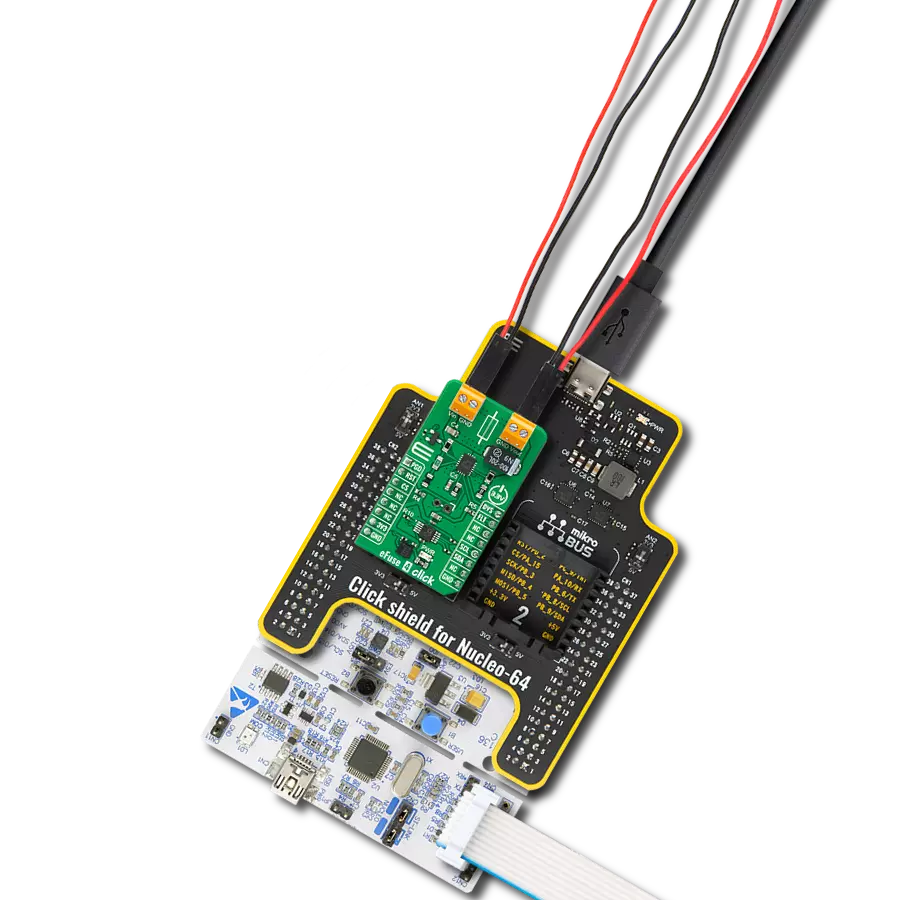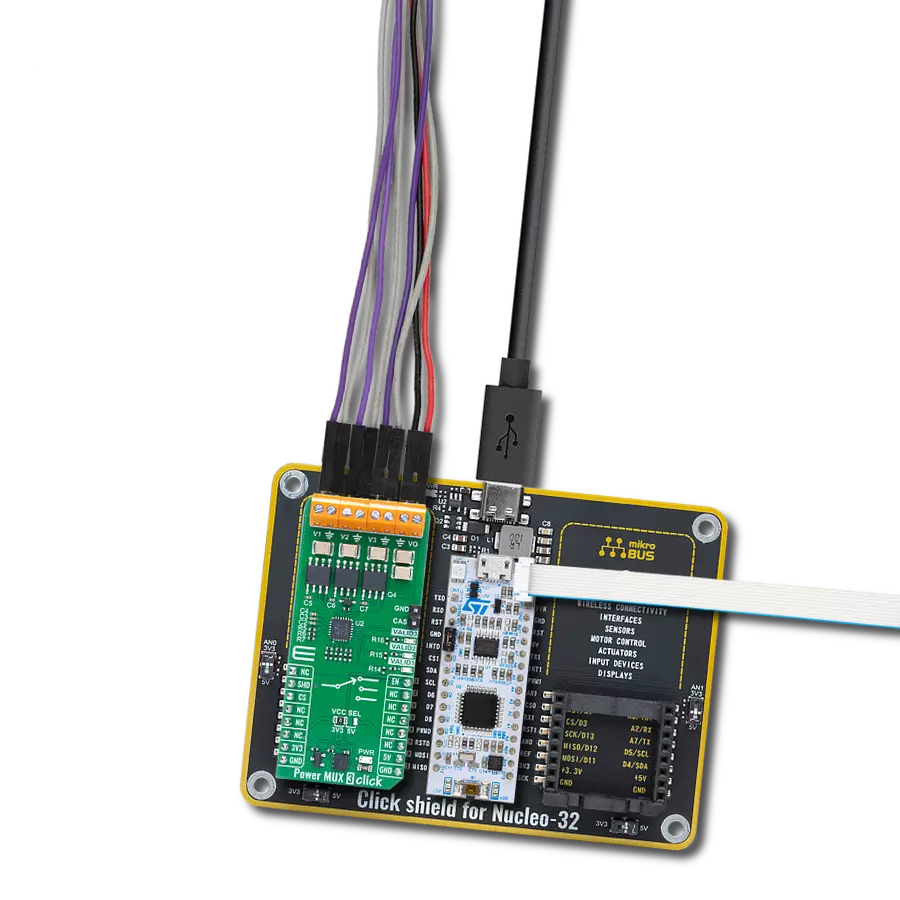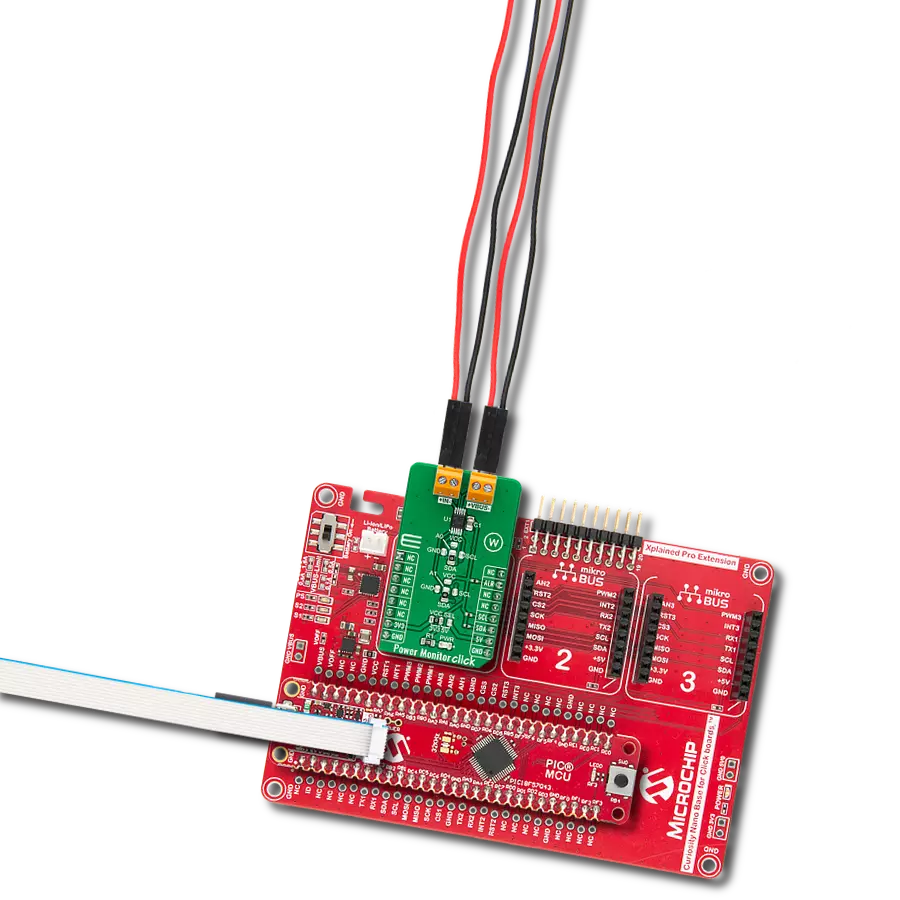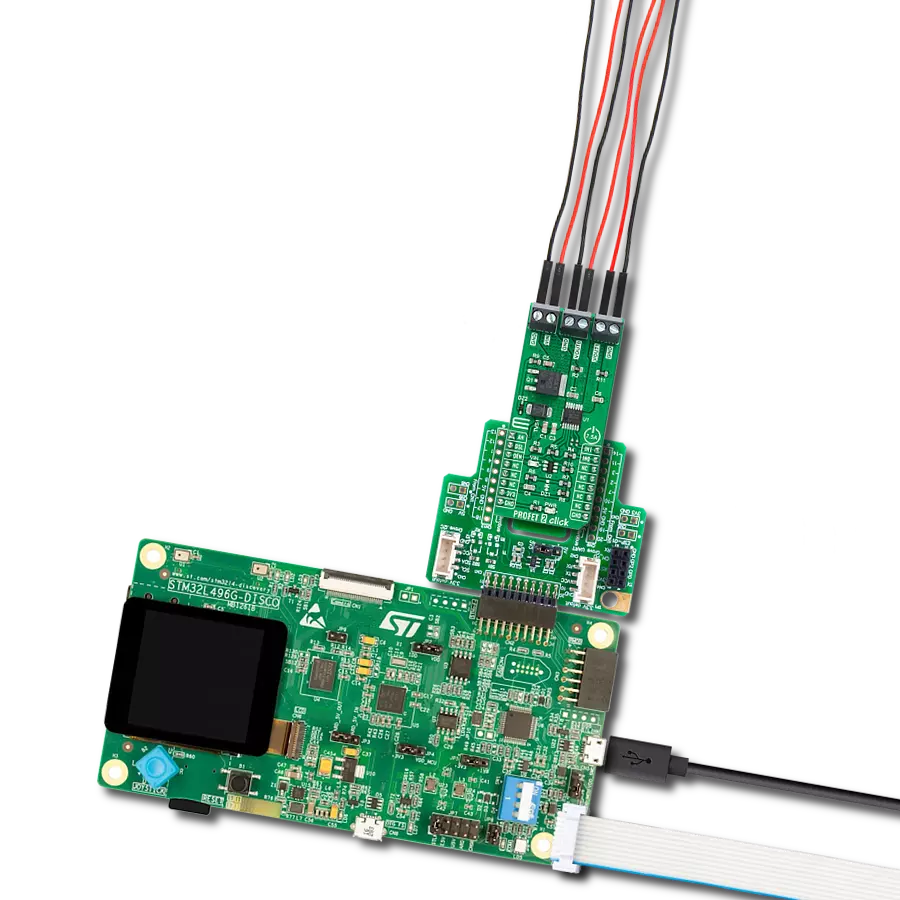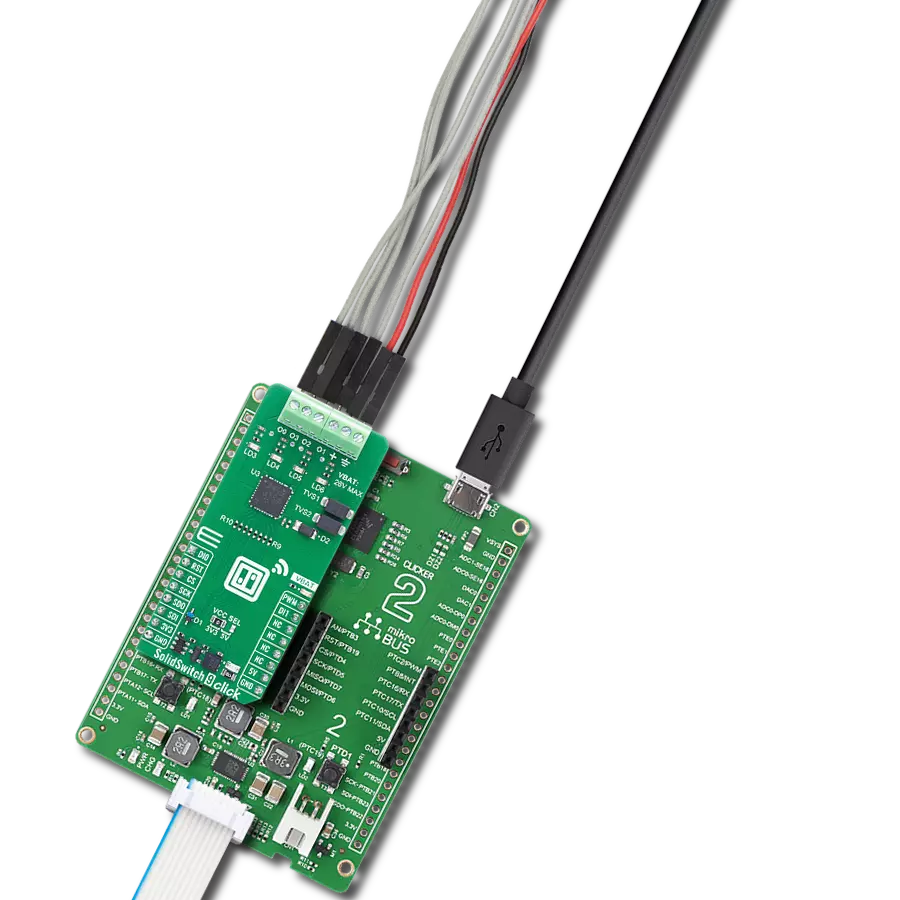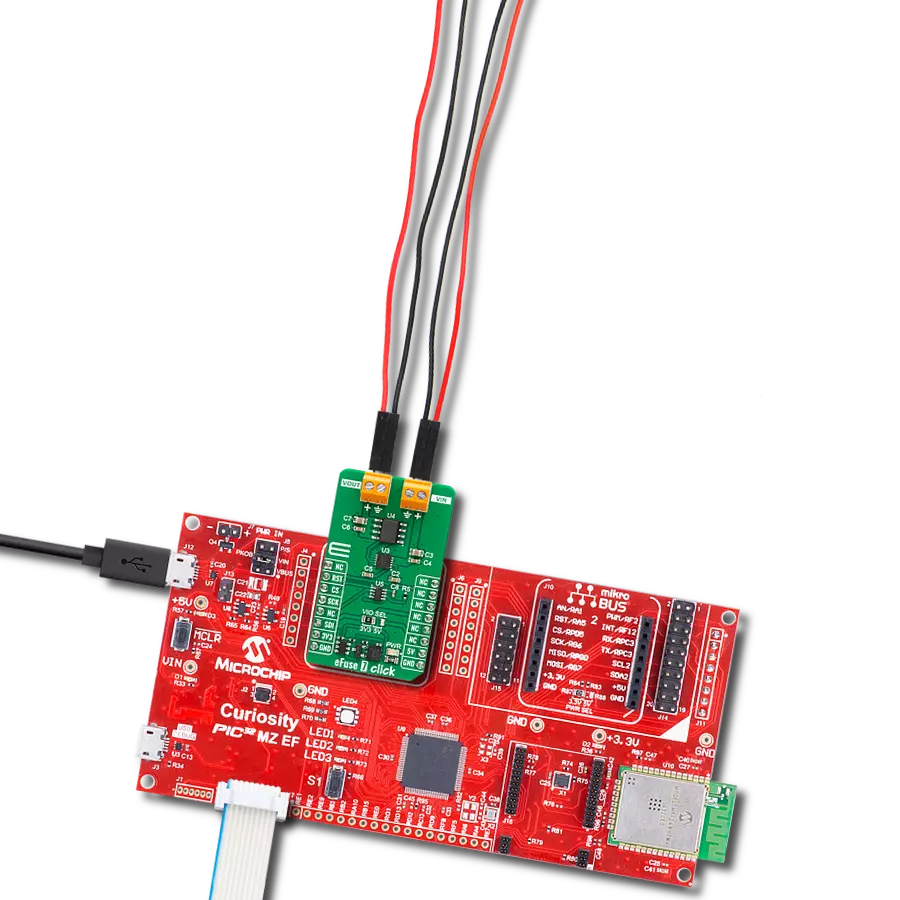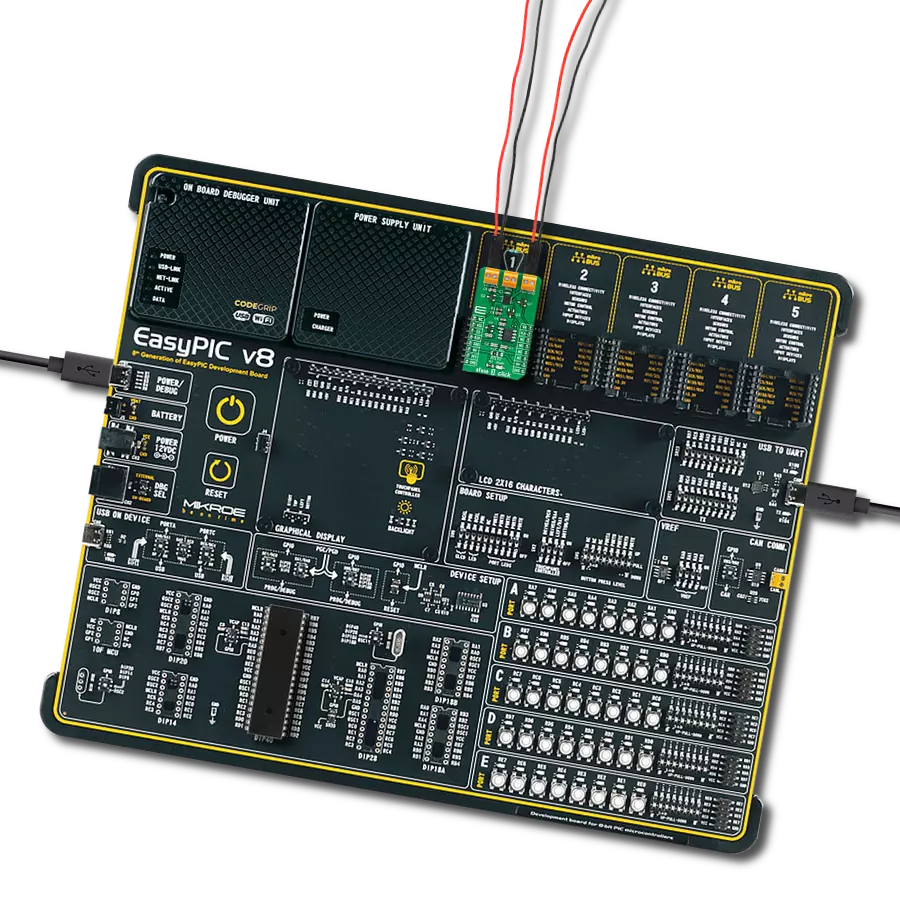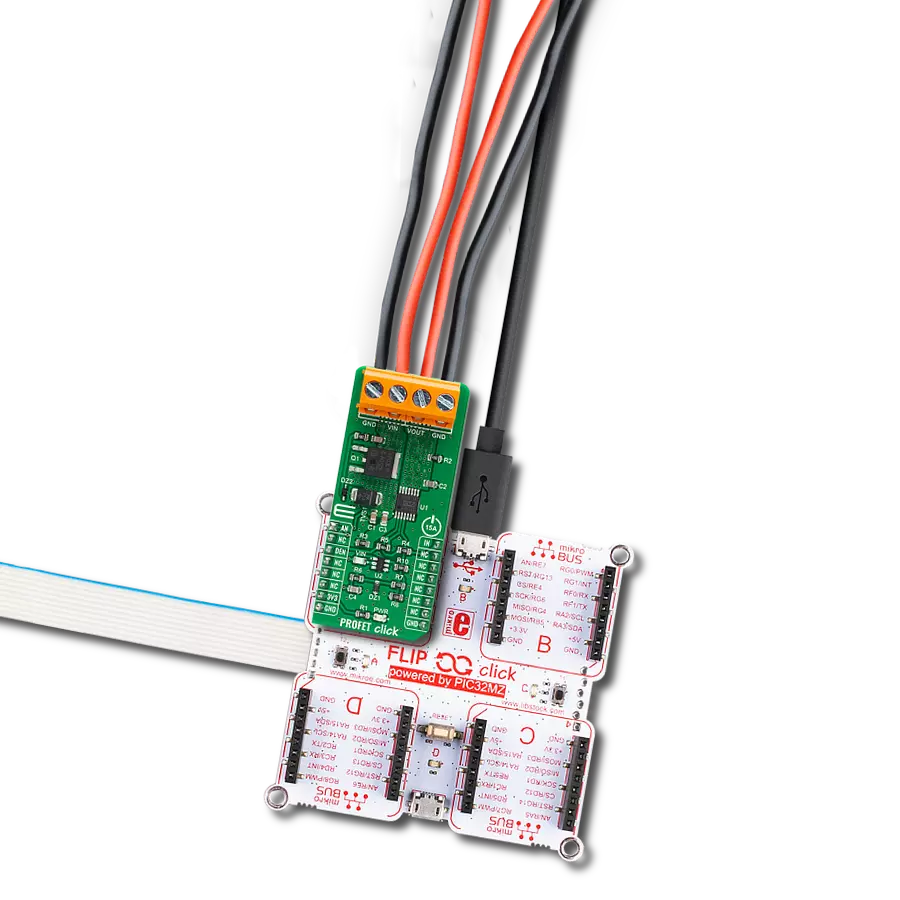Ensure that your projects receive the right amount of power and are protected from potential damage due to excessive current
A
A
Hardware Overview
How does it work?
Current Limit 9 Click is based on the NPS4053, a load switch with a precision adjustable current limit from Nexperia. It limits the output current to a constant current using a constant-current mode when the output load exceeds the current limit threshold or is shorted. An internal voltage comparator turns off the load switch to protect devices on the input side of the switch when the output voltage is higher than the input. The other protections include active reverse voltage protection, ILIM pin protection, ESD protection, and more. The current to which you can set the limit over the Current Limit 9 Click board™ can be
selected between external supply or 5V from the mikroBUS™ socket via the VIN SEL jumper. The external voltage can be in the range of 2.5 – 5.5V. It can use the MAX5419, a 256-tap 200K nonvolatile digital potentiometer from Analog Devices, to set the current limit threshold to the NPS4053 over the ILIM pin. It can also use an onboard R9 resistor for a fixed 0.5A at 5V supply. The selection can be made over the ILIM SEL. Current Limit 9 Click uses a standard 2-Wire I2C interface of the MAX5419 to allow the host MCU to set the desired current limit threshold, which supports a fast I2C interface. You can turn the
current limit IC on or off over the ON pin. The FLT is an interrupt pin, and it is asserted to a low logic level during overcurrent, overtemperature, and reverse-voltage conditions. This Click board™ can operate with either 3.3V or 5V logic voltage levels selected via the VCC SEL jumper. This way, both 3.3V and 5V capable MCUs can use the communication lines properly. Also, this Click board™ comes equipped with a library containing easy-to-use functions and an example code that can be used as a reference for further development.
Features overview
Development board
UNI-DS v8 is a development board specially designed for the needs of rapid development of embedded applications. It supports a wide range of microcontrollers, such as different STM32, Kinetis, TIVA, CEC, MSP, PIC, dsPIC, PIC32, and AVR MCUs regardless of their number of pins, and a broad set of unique functions, such as the first-ever embedded debugger/programmer over WiFi. The development board is well organized and designed so that the end-user has all the necessary elements, such as switches, buttons, indicators, connectors, and others, in one place. Thanks to innovative manufacturing technology, UNI-DS v8 provides a fluid and immersive working experience, allowing access anywhere and under any
circumstances at any time. Each part of the UNI-DS v8 development board contains the components necessary for the most efficient operation of the same board. An advanced integrated CODEGRIP programmer/debugger module offers many valuable programming/debugging options, including support for JTAG, SWD, and SWO Trace (Single Wire Output)), and seamless integration with the Mikroe software environment. Besides, it also includes a clean and regulated power supply module for the development board. It can use a wide range of external power sources, including a battery, an external 12V power supply, and a power source via the USB Type-C (USB-C) connector. Communication options such as USB-UART, USB
HOST/DEVICE, CAN (on the MCU card, if supported), and Ethernet is also included. In addition, it also has the well-established mikroBUS™ standard, a standardized socket for the MCU card (SiBRAIN standard), and two display options for the TFT board line of products and character-based LCD. UNI-DS v8 is an integral part of the Mikroe ecosystem for rapid development. Natively supported by Mikroe software tools, it covers many aspects of prototyping and development thanks to a considerable number of different Click boards™ (over a thousand boards), the number of which is growing every day.
Microcontroller Overview
MCU Card / MCU
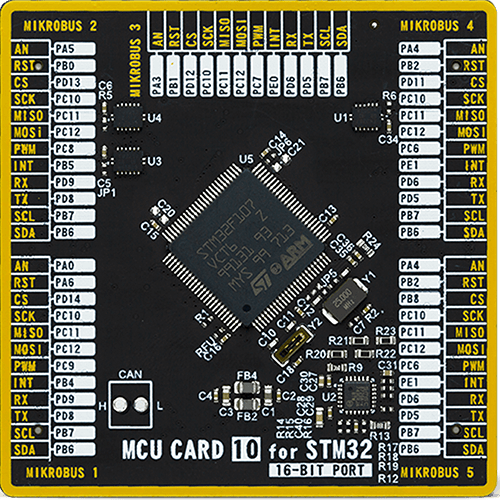
Type
8th Generation
Architecture
ARM Cortex-M3
MCU Memory (KB)
256
Silicon Vendor
STMicroelectronics
Pin count
100
RAM (Bytes)
65536
Used MCU Pins
mikroBUS™ mapper
Take a closer look
Click board™ Schematic

Step by step
Project assembly
Software Support
Library Description
This library contains API for Current Limit 9 Click driver.
Key functions:
currentlimit9_set_limit- This function sets the desired current limit threshold using the I2C serial interface.currentlimit9_get_fault- This function gets the state of the fault flag to indicate overcurrent, overtemperature, or reverse-voltage conditions.currentlimit9_enable- This function turns on the power switch and enables the internal MOSFET.
Open Source
Code example
The complete application code and a ready-to-use project are available through the NECTO Studio Package Manager for direct installation in the NECTO Studio. The application code can also be found on the MIKROE GitHub account.
/*!
* @file main.c
* @brief Current Limit 9 Click example
*
* # Description
* This library contains API for the Current Limit 9 Click driver.
* This driver provides the functions to set the current limiting conditions
* in order to provide the threshold of the fault conditions.
*
* The demo application is composed of two sections :
*
* ## Application Init
* Initialization of I2C module and log UART.
* After driver initialization, the app executes a default configuration
* and sets the current limit threshold of 460 mA.
*
* ## Application Task
* This example demonstrates the use of the Current Limit 9 Click board.
* The demo application checks the fault flag for overcurrent conditions.
* Results are being sent to the UART Terminal, where you can track their changes.
*
* @author Nenad Filipovic
*
*/
#include "board.h"
#include "log.h"
#include "currentlimit9.h"
static currentlimit9_t currentlimit9;
static log_t logger;
void application_init ( void )
{
log_cfg_t log_cfg; /**< Logger config object. */
currentlimit9_cfg_t currentlimit9_cfg; /**< Click config object. */
/**
* Logger initialization.
* Default baud rate: 115200
* Default log level: LOG_LEVEL_DEBUG
* @note If USB_UART_RX and USB_UART_TX
* are defined as HAL_PIN_NC, you will
* need to define them manually for log to work.
* See @b LOG_MAP_USB_UART macro definition for detailed explanation.
*/
LOG_MAP_USB_UART( log_cfg );
log_init( &logger, &log_cfg );
log_info( &logger, " Application Init " );
// Click initialization.
currentlimit9_cfg_setup( ¤tlimit9_cfg );
CURRENTLIMIT9_MAP_MIKROBUS( currentlimit9_cfg, MIKROBUS_1 );
if ( I2C_MASTER_ERROR == currentlimit9_init( ¤tlimit9, ¤tlimit9_cfg ) )
{
log_error( &logger, " Communication init." );
for ( ; ; );
}
if ( CURRENTLIMIT9_ERROR == currentlimit9_default_cfg ( ¤tlimit9 ) )
{
log_error( &logger, " Default configuration." );
for ( ; ; );
}
if ( CURRENTLIMIT9_ERROR == currentlimit9_set_limit( ¤tlimit9, CURRENTLIMIT9_LIMIT_0_46_A ) )
{
log_error( &logger, " Current limit threshold." );
for ( ; ; );
}
log_info( &logger, " Application Task " );
Delay_ms ( 100 );
}
void application_task ( void )
{
if ( CURRENTLIMIT9_FAULT_FLAG == currentlimit9_get_fault( ¤tlimit9 ) )
{
log_printf( &logger, "Fault flag: Overcurrent\r\n" );
}
else
{
log_printf( &logger, " Current limit is 460 mA\r\n" );
}
Delay_ms ( 1000 );
}
int main ( void )
{
/* Do not remove this line or clock might not be set correctly. */
#ifdef PREINIT_SUPPORTED
preinit();
#endif
application_init( );
for ( ; ; )
{
application_task( );
}
return 0;
}
// ------------------------------------------------------------------------ END




















